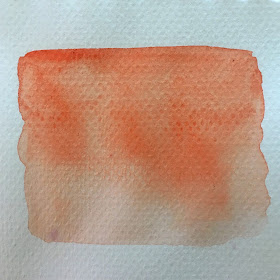I hope you enjoyed my tutorial on "Watercolor Techniques".
Today's post will cover some easy watercolor washes that come handy every time you pick up your brush to start a painting.
I have come up with a fun little project for you. All you need to do is gather the following supplies and follow the tutorial!
You will need:
Watercolor paper/ Sketchbook
Watercolor paints
Paint brush
Water
Flat wash
A flat wash is a wash that is completely even in tone. Mix a generous amount of cerulean blue wash in your palette. Load a clean brush and apply a smooth wash across the page. Working quickly, reload your brush again and continue where you left off. Try to avoid any variation in tone and if you are working on a large paper, I'd recommend you use a bigger brush.
Gradated wash
 |
| Flat wash |
Gradated wash
It is a wash that is applied in a similar manner as the flat wash but there is a variation in tone. Load your brush with orange paint and apply a smooth wash across the page. Then add more water as you work your way down so that the color gradually gets lighter. Similarly you can add more of the same pigment to the wash so that it gradually becomes darker in tone.
Variegated wash
This is a variation of the gradated wash but instead of adding more water you gradually introduce another color. This is great for when you are painting sunsets.
Wet on wet wash
This is can be done in two ways. Load brush with clean water and wet the entire area. While the paper is still wet, apply paint. Dropping gorgeous colors on to damp paper is an exhilarating experience as you can never predict exactly what will happen or how far the paint will spread on paper.
 |
| Wet on wet |
Wet on dry wash
This is pretty easy. Just load your brush with wet paint and apply it to dry paper. The resulting wash will have harder edges as compared to a wet on wet wash.
Dry on dry wash
With as little water as possible (water should only slightly moisten the brush), load your brush with hookers green. Then holding the brush at an angle drag it across the page. This wash is good for creating texture like when you want to paint grass, rocks or textured walls.
I hope you enjoyed learning these basic watercolor washes. You can also check out my Watercolor Valentine Heart tutorial and see how I have used some of these washes there.
And when you combine some of the basic washes with watercolor texture techniques you can create something like this:
Any questions about this post or Watercolor Techniques Tutorial? I'd love to read your feedback!
And when you combine some of the basic washes with watercolor texture techniques you can create something like this:
 |
| Teapot |
Any questions about this post or Watercolor Techniques Tutorial? I'd love to read your feedback!
Cheers until next time :)











No comments:
Post a Comment